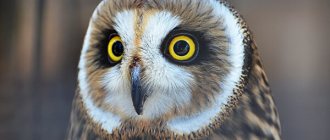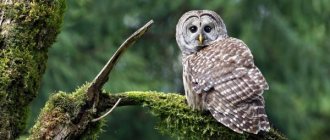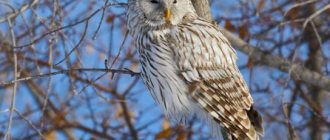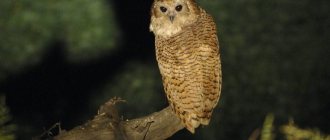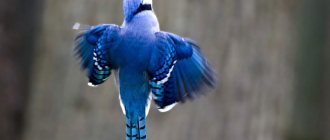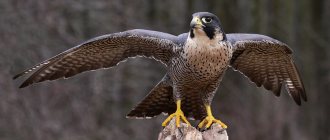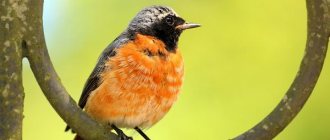- Wild animals
- >>
- Birds
The tawny owl is a nocturnal bird of prey from the owl family. These are dangerous hunters with excellent hearing, exterminating rodents and other small animals. They can live either deep in the forest or right in the city, settling in an abandoned building. They are usually not dangerous to people unless they are protecting a nest.
Common or gray owl
Latin name
— Strix aluco
English name
— Tawny owl
Squad
- Owls
Family
- True owls or owls
In nature, there are two color forms of the tawny owl - gray and brown, and the color varies depending on the geographical distribution of the species. For example, owls living in the British Isles are predominantly tawny, while on the European mainland gray birds predominate. Ural and Siberian owls are also predominantly gray, and the more east the area is, the fewer tawny individuals are found there. On the territory of Russia, the ratio of gray and red individuals is approximately the same, and the further south you go, the greater the predominance of red individuals.
Natural enemies of owls
Photo: Gray owl
There are no specialized enemies - that is, no one intentionally hunts them. But this does not mean that owls are not in danger - in fact, there are quite a lot of them. In addition to deadly diseases and lack of nutrition, which are very common causes of their death, large birds of prey can also be dangerous.
Tawny owls are primarily threatened by eagles, golden eagles and hawks. Even though they are about the same size, these birds have much more advanced wings, giving them an advantage, and they are also more aggressive and adapted to fight other birds.
Although the tawny owl is capable of standing up for itself, especially if it had to defend the nest - in this case, it fights with any aggressor, regardless of the odds, even if a bear decides to feast on the eggs. Therefore, it is better not to approach the nest - an enraged bird can even lose an eye.
Danger can also come from larger owls, primarily eagle owls, as well as from fellow tribesmen - usually owls do not conflict with each other, but exceptions do occur. Most often, they are associated with overpopulation of the area by owls, due to which conflicts arise between them for food.
No less often, the cause of death of a tawny owl is a person: they are shot by hunters, they fall into traps set for rodents, or they are poisoned due to the fight against the same rodents with the help of zinc phosphide.
Spreading
The tawny owl inhabits deciduous and mixed forests of the Palaearctic, i.e. it is found in Europe, Asia and North Africa. Its range extends from the Mediterranean to the southern borders of the taiga. In East Asia, a virtually isolated area with similar natural conditions is known. In such a vast range, there are 11 subspecies of this owl.
Most often, the tawny owl prefers deciduous and mixed forests, but feels good in coniferous forests and city parks.
Where does the tawny owl live?
Photo: Great Gray Owl
The habitat depends on the species, sometimes they may not even overlap.
Eg:
- The Chaco owl lives in the Gran Chaco in South America, as well as in the surrounding areas;
- The Great Tawny Owl prefers to live in Egypt, Syria, Israel and Saudi Arabia;
- black-and-white and spotted tsikkabs live in Central America, Venezuela, Colombia, Ecuador;
- gray owl - in the taiga from the Murmansk region to Primorye.
Besides these, there are many other types. One of them can be found almost everywhere: from the south of Argentina to the equator and the Arctic Circle. At the same time, they are sedentary, that is, they live in the same place where they were born. If a tawny owl moves away from its birthplace, it is only because conditions there have worsened, and usually not far away.
They live in deciduous, coniferous or mixed forests, but it cannot be said that they are very demanding of their environment, and sometimes they can even settle right in cities, choosing trees in the park or unused attics - they are attracted by the fact that it is much easier to get food in the city, than in the forest.
Nevertheless, most of the owls are not tempted by this and live in forests; for nests they choose hollows in old trees or simply settle in the abandoned nest of another bird. They don’t live in the mountains - they don’t climb higher than 2,000 meters, and they can rarely be seen at these altitudes.
They choose places to live close to clearings or forest edges - they are best able to hunt in open space, and not in a dense forest, where it is far from so convenient to do so.
Appearance
The usual size of this species of owl is 36-38 cm, weight is about 500 g. Like many other species of owls, ♂♂ is always smaller than ♀♀. The head is large, round and can rotate almost 270o; there are no feather “ears” on the head. The facial disc is well defined and bordered with dark feathers. The wings are quite short and wide, reaching almost 1 m in span.
The color of the tawny owl is monochromatic (more gray or more red), but with streaks, which makes an owl sitting on a tree completely invisible. The chest and belly are lighter than the back. The eyes and claws are dark, almost black, the beak is yellow.
Description of the bird
Birds are well studied and classified. There are more than 18 species of Tawny Owl. The average life expectancy in the wild is 5 to 8 years. An isolated incident occurred more than 30 years ago. Then the ringed female lived in the wild for 18 years and 6 months. In zoos, owls lived up to 20 years.
What does it look like
The size of adult individuals is no more than 36–40 cm. Average weight is about 600 grams. The wings are wide and rounded. The span is more than 1 meter. There are no ears characteristic of other species.
The head is round, well feathered. The face disc has a black border. The body is covered with thick plumage. The main coloring is variegated, maybe gray or reddish. The chest and belly are light gray or beige. The tail is wide and fan-shaped.
The beak is yellow, hook-shaped, the claws are black or brown. The paws are four-toed: 2 toes point forward and 2 back. The claws are sharp and curved inward. The eyes are large, round, directed forward. Usually yellow or light brown in color. There are dark rims around the eyes.
The difference between a female and a male
Sexual dimorphism is weakly expressed. Externally, it is almost impossible to distinguish owls by color. Females are slightly larger than males. The weight of an adult female is from 0.8 to 1.2 kg, males do not exceed 1 kg.
Character and lifestyle
Owls are active only at night. During the day, representatives of the species hide in hollows or shade of trees. Tawny owls are able to adapt to climate and environmental changes. They live well in close proximity to people.
Gray Owls are very warlike and selflessly protect their territory. Adult birds lead a sedentary lifestyle and rarely change their habitat. They live in pairs and family groups, which are formed from growing chicks. By autumn, young individuals leave the parental nest.
What does it eat?
The Gray Owl is a nocturnal predator. Owls fly out to hunt at sunset and continue searching for prey until sunrise. Thanks to their excellent hearing, owls can hear the slightest rustles.
They usually attack from an ambush, guided by sounds. First, the bird of prey stuns its prey with blows of its wings, and then kills it using its sharp beak and claws.
Sometimes owls hunt in flight. They fly over bushes and grass and scare small animals by beating their wings on branches. The victims leave their night shelter in panic and become food for feathered predators. Large prey is torn apart by the owl with its beak, and small prey is swallowed whole.
Basic diet:
- Rodents: voles, brownies, moles, squirrels, shrews, hares, chipmunks.
- Reptiles: frogs, lizards, snakes.
- River inhabitants: fish, shellfish, crayfish.
- Birds: sparrows, jackdaws, robins, wagtails, redstarts. Often chicks and eggs become prey.
- Insects: grasshoppers, locusts, moths, etc.
The diet of owls depends on their habitat. Diet may vary depending on region. Predators do not fly far from their nests. The radius of the territory for night hunting is from 400 to 600 meters.
Scientists have confirmed that in the Great Gray Owl's habitat, the number of harmful rodents is significantly lower. An adult is capable of killing more than a hundred mice in a month. Farmers are building artificial nesting boxes for owls to attract predators to their fields.
Fishermen who hunt for owl skins do not like them. Because feathered robbers ruin traps and spoil the skins of animals.
Where does it live?
Owls are widespread in the countries of Central Asia, Eastern Europe, and Northwestern Siberia. Birds prefer mixed deciduous, coniferous and beech forests, park areas, and homestead groves.
The main criterion for the life of the Gray Owl is comfortable hollows for nesting and daytime rest. Therefore, owls are found in almost any forest. Birds are not afraid to be neighbors with humans, so they are happy to settle near homes and in artificial nests.
Common Tawny Owls lead a predominantly sedentary lifestyle and rarely change their habitat. Only young individuals migrate short distances. Perhaps this is due to the expansion of hunting territories and the formation of new flocks of grown young animals.
Reproduction
Individuals become sexually mature already in the first year of life. Young animals born in the spring are able to reproduce by the next season. The nesting period begins in February or March and depends on the climatic conditions of the region. During the mating season, males make calling sounds and bring prey to their chosen ones.
Tawny owls nest in hollows, old stumps, small dry crevices, attics or in grass. There have been cases when owls occupied crow or magpie nests.
Usually the clutch consists of 3–4 eggs, less often 7–8. The egg is round in shape and the shell color is white. The incubation period is about 30 days. Females begin incubating the clutch with the first egg, so the cubs are born at different ages. The difference between the chicks is from 2 to 10 days. The male does not participate in incubation, but takes care of the female and the growing offspring.
Pairs form at the beginning of the mating season and remain for life. Sometimes there are families with two females and one male. At the same time, females incubate eggs on different nesting sites.
The chicks hatch unadapted to independent life and require constant care and attention. Newborn chicks are blind and deaf. On the third day of life, the owlets begin to demand food and make characteristic hoarse sounds. When the owlets are 10 days old, the female begins to fly out to hunt along with the male.
Young owlets leave the nest at the age of 1-1.5 months, but are finally separated from their parents only in the fall. Gray Owls are caring parents and protect their brood even when attackers are significantly larger than them.
Natural enemies
Tawny owls are quite warlike and are able to repel almost any predator. Protecting nesting sites, owls are capable of attacking even a bear. The sharp beak and claws pose a real threat and are a formidable weapon.
Tawny Owls have few natural enemies; the threat mainly comes from large diurnal birds of prey. Hawks, eagles or golden eagles can attack nesting sites or adults. Sometimes owls become prey for eagle owls, martens, foxes or wolves.
The main dangers are diseases, highways, deforestation, electrical wires, traps. Owls may die from starvation. And also from poisoning by rodents that die as a result of deratization with chemicals.
Wintering
The Gray Owl does not fly away for the winter, but can change its habitat. The reasons may be a lack of food or species overpopulation.
Representatives of the species winter in hollows and attics. Sometimes during severe cold weather, owls move to parks and garden areas closer to human habitation. During the cold season, the Tawny Owl stays close to the habitats of rodents.
Nutrition and feeding behavior
The main prey of the tawny owl is, of course, mouse-like rodents and other small mammals (moles, shrews, and sometimes young hares). But often it also catches small birds, as well as frogs, reptiles, insects, mollusks, and near water – crustaceans and fish.
The tawny owl hunts at night, most often from ambush, using its excellent hearing. Having detected prey by the slightest rustle in the grass, the owl glides or suddenly falls on it. Having covered the prey with its wide wings, it then kills it with blows of its beak or tears it with its claws.
Sometimes these owls hunt in flight, scaring away small birds sleeping in the bushes by beating their wings on branches.
Origin of the species and description
Photo: Tawny Owl
There are several main versions of the origin of birds. According to one of them, Archeopteryx is considered the oldest species, and they appeared in the Jurassic period and were related to the maniraptor dinosaurs. According to another hypothesis, they arose earlier, back in the Triassic period, and descended from archosaurs, and the first bird was Protoavis.
But before the appearance of owls, in particular owls, it was still far away - it is assumed that their ancestors were arboreal climbing birds related to Coraciiformes, and the first owls appeared at the end of the Paleocene.
Video: Tawny Owl
The oldest owl known to science is the fossil Ogygoptynx wetmorei. The genus to which she belonged became completely extinct, like the other owls that appeared first. The oldest owls found by paleoantologists date back to the Lower Pleistocene - so they lived about 600,000 years ago, which is very short by evolutionary standards.
It is assumed that the oldest owls were active during the day and fed mainly on insects, perhaps specializing in carrion. Over time, they switched to a nocturnal lifestyle - this was largely due to the fact that the largest insects are active at night, and owls adapted to their rhythm of life.
Moreover, at night they had much less competitors. Over time, their priorities changed, and they began to feed primarily on rodents, although many modern owls, including owls, sometimes eat insects. They also developed their own hunting style, based not on flight speed, like daytime birds, but on secretly stalking prey and a sudden attack.
The scientific description of owls was made by Carl Linnaeus in 1758, he also gave the genus the name Strix, and also described many individual species. This process continued throughout the 18th-20th centuries, and the desert owl was identified only in 2015; it was previously considered a subspecies of the pallid owl.
Vocalization
The vocalizations of tawny owls are very diverse. The male's call is a long, howling oooh, oooh, oooh, most often heard during mating season. With this hoot, the male notifies other birds that the territory is occupied; With a similar cry, he calls the female, and also informs her that he is bringing food to the nest. The female's voice is a long, rolling, bass trill, slightly reminiscent of the whistle of a distant train. In general, during the mating period, tawny owls are quite “talkative” birds and, apparently, various fears of owls are associated with their night cries. The rest of the time, outside the breeding season, tawny owls behave very quietly and silently.
Habitats
The distribution area of owls is large - Europe, North Africa, Asia and America. Habitats by species:
- The tawny owl lives in the forests of the Palearctic region.
- Pale is found in the deserts and rocks of the Middle East, Egypt and the Arabian Peninsula.
- The Brazilian one lives in the forests of South America.
- The great gray owl is distributed in the taiga and mountain forests from the Kola Peninsula to the Russian Far East.
- The spotted one lives in western North America, and the red-legged one lives in South America.
- The longtail is found from the forests of Europe to the Pacific coast, including Sakhalin.
- The African tsikkaba is distributed south of the savannahs of Africa.
- The zebra and red-striped ciccaba live in South America.
- The desert owl lives in the Middle East.
Reference! There are little-studied species. For example, David's owl lives in the mountains of Central China.
Reproduction and parental behavior
The tawny owl begins nesting very early. Already in February, males can be observed mating, and clutches appear in March-early April. The nest is simple, usually located in a hollow or in an old stump, but it can also be right on the ground. Tawny owls often occupy other people's nests, mainly crows' nests.
A clutch usually contains 2-4 round white eggs, but in years rich in food, nests with 7-8 eggs were found. The incubation period lasts about 30 days, dense incubation begins with the first egg, so the chicks in the same nest are of different ages. Only the female incubates.
At the end of April, blind, helpless chicks with closed ears already appear in most nests. On the second day they already begin to hear and see. During the first week, only the male gets food, but when the chicks are 6-7 days old, the female leaves them alone in the nest and flies off to hunt. The chicks stay in the nest for about a month, but even after they have fledged, the young live with their parents on their territory, and only in the fall does the brood break up.
Adult tawny owls protect the nest and chicks very actively and selflessly.
Features of character and lifestyle
Photo: Tawny Owl
Tawny owls hunt in the dark, but not necessarily at night - they often do this in the evening twilight or early morning before dawn. In this regard, different species have their own preferences. Some owls even hunt during the day, and even those that are usually active at night can sometimes do this during the day, especially in winter.
The owl usually has quite a lot of time free from hunting and sleep; it spends it in its nest or nearby, usually not showing much activity and just resting. At the same time, she is always on the alert and ready to attack even when she is resting.
If a tawny owl notices something suspicious, it silently observes, trying not to give anything away. If she decides that the danger is serious, she flies away just as silently, or attacks if she needs to protect the chicks. Tawny owls make almost no sounds at all, but at sunset they sometimes start a roll call.
Then they begin to prepare for the hunt: they can fly a little in advance, usually low above the ground - during such flights they look out for future victims. Such flights become more frequent if there is little prey, and when there is an abundance of it, the bird usually does not worry and does not conduct such “reconnaissance.” If there is a constant shortage of prey around her home, she may fly to another place.
The lifespan of owls is determined by their size - the larger these birds, the longer they live on average. Tawny owls, accordingly, have a short lifespan, usually about 5 years, while in larger species it can reach up to 7-8 years.
Interesting fact: Although tawny owls are usually sedentary, sometimes large numbers of individuals can fly long distances at once. In particular, they can settle in areas where this species was not previously represented at all, thus expanding their range. Young birds take part in such mass migrations when they grow up in autumn.
Lifestyle
Mainly leads a purely nocturnal lifestyle. Various studies show that the owl's waking period is from 8 pm to 3 am. As a rule, it disappears when the first rays of the sun appear. However, when white nights begin in the territory, the animal appears during the day.
The bird hunts mainly at night, and towards morning it eats its prey and begins to sleep. Lives mostly alone and starts a flock only after breeding. But adult chicks eventually leave the parental nest.
